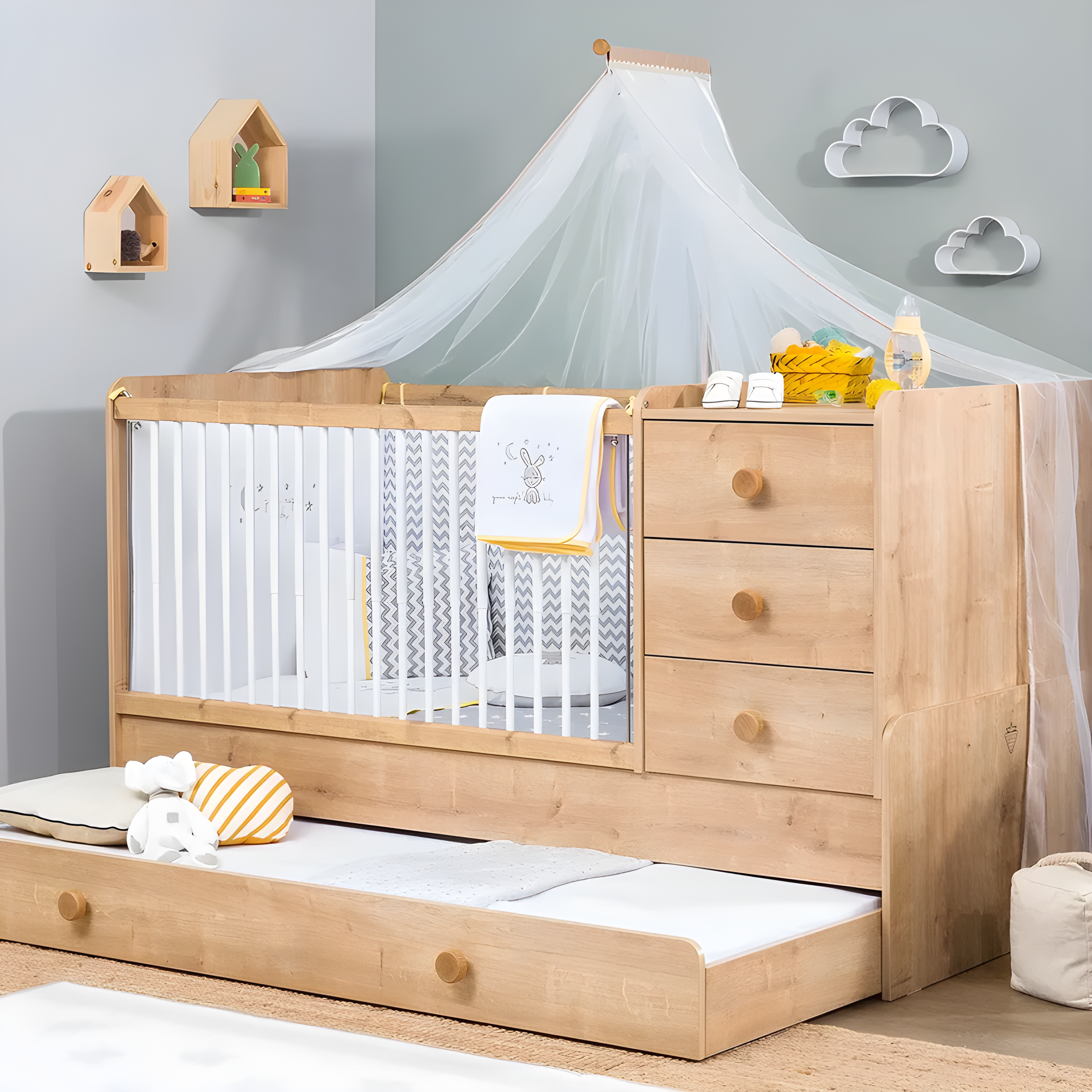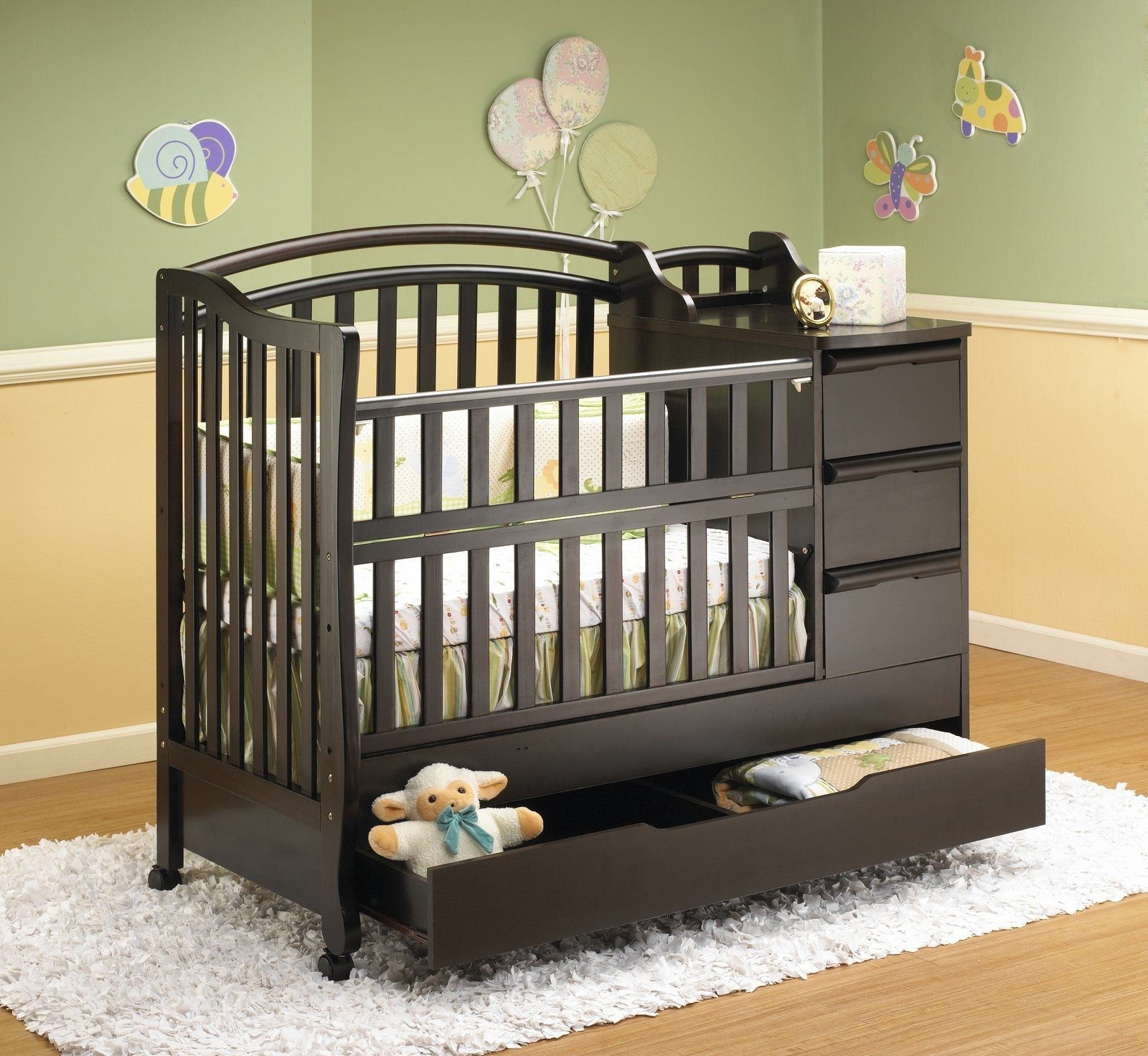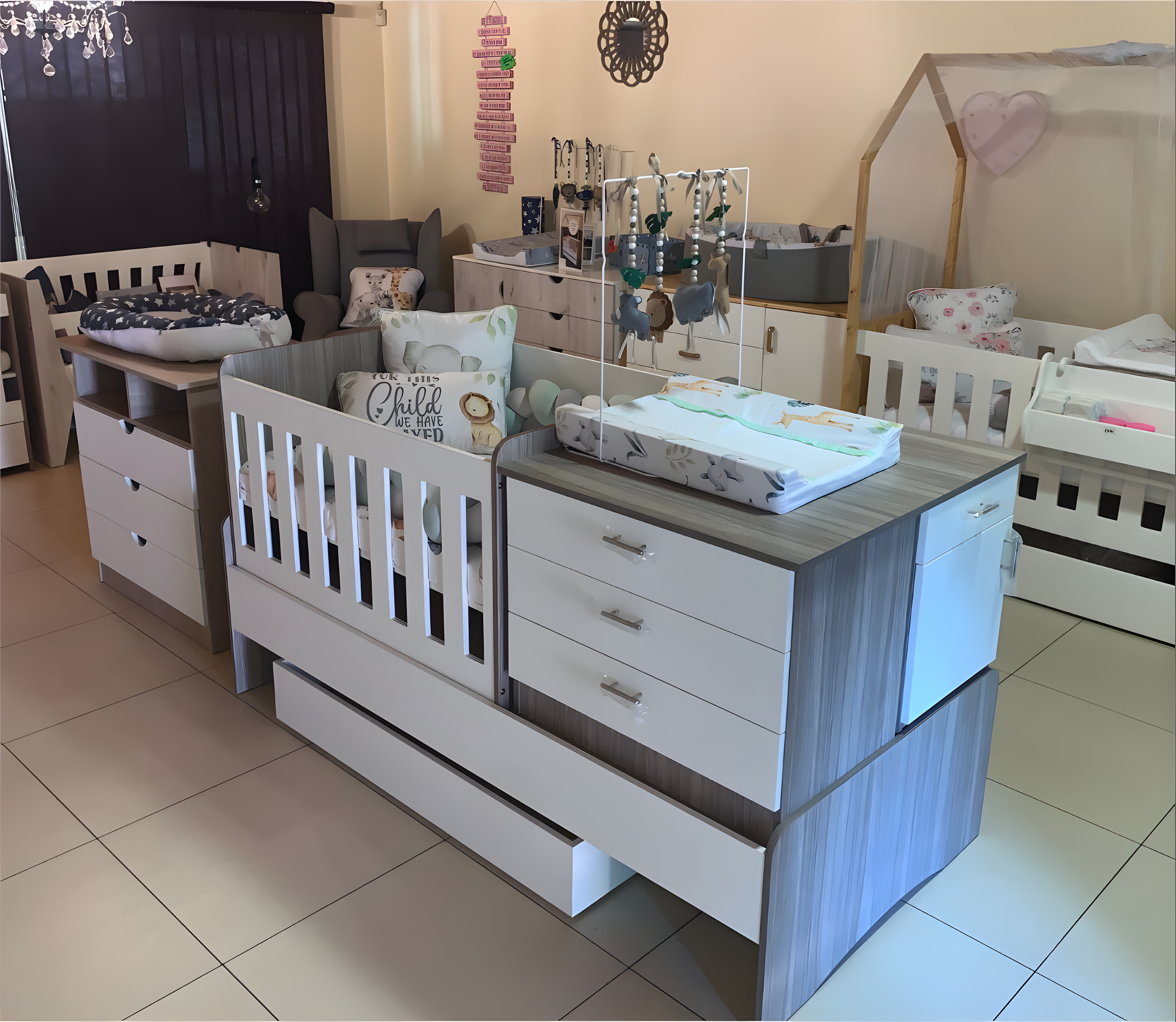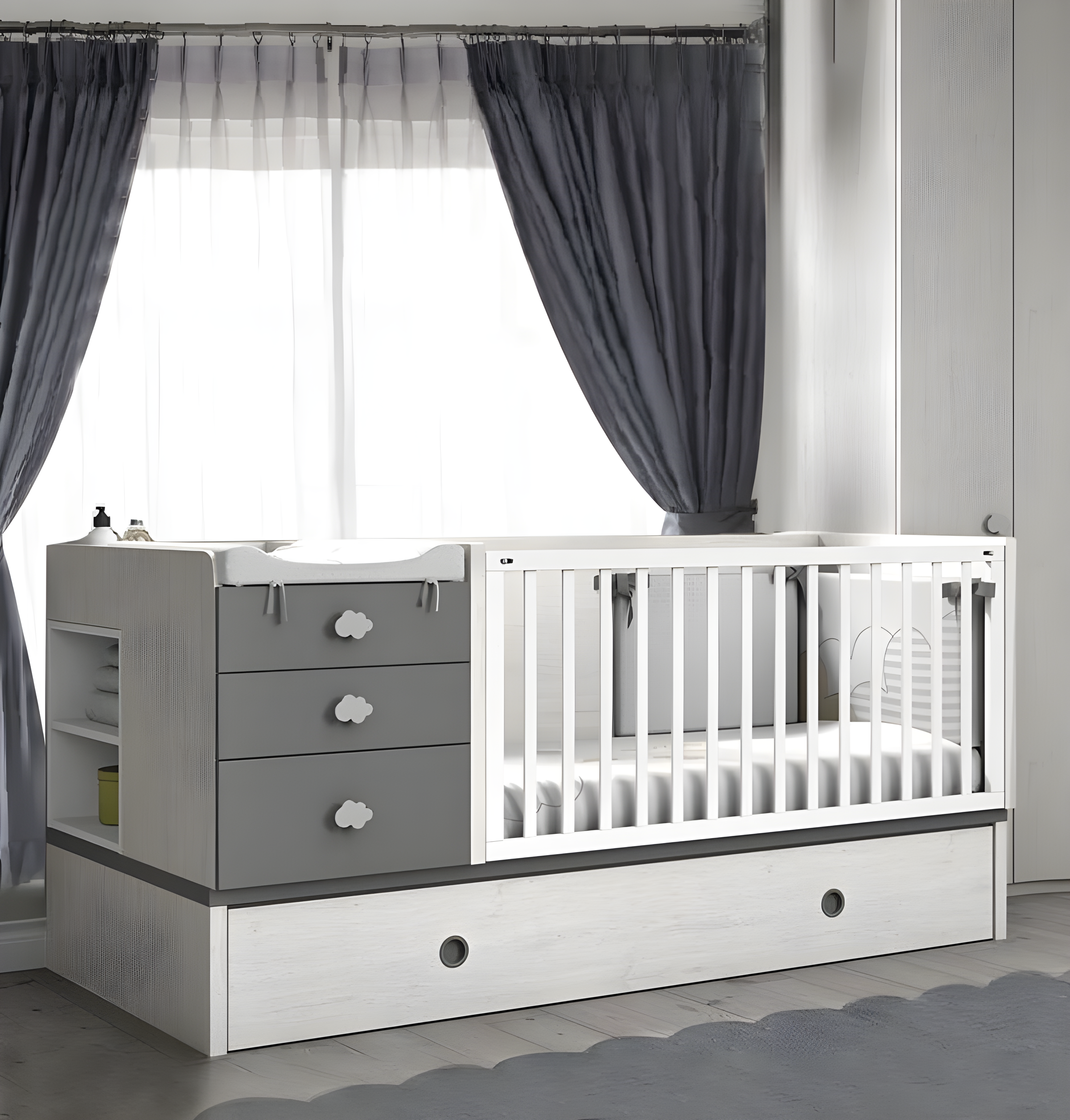
The Hidden Power of Built-In Storage
When I first became a sleep consultant, I underestimated the humble drawer under a crib. It felt like a small bonus, not a necessity. But after walking into countless nurseries at 3 a.m., watching parents fumble through dim hallway light just for a spare swaddle, I realized those drawers are often the unsung hero of nighttime survival.
One mom shared her story: she kept a drawer with clean onesies and backup pajamas. She said, “I didn’t even know I needed it until I heard our baby stirring and everything I needed was just there.” That quiet convenience — no light, no stumbling, no pause in the rhythm — that’s the real magic of a drawer.
Storage at hand doesn’t just save steps — it saves sanity during the sleep haze when every minute counts.
In small apartments or shared bedrooms, a dresser might not be practical. The crib drawer isn’t just furniture — it’s a strategy. You’re designing your baby’s sleep ecosystem, and when everything you need is in reaching distance, the small wins become real relief.
What Truly Fits in the Drawer
At first glance, the drawer under your crib seems like a decent spot to toss in an extra swaddle or two. But let’s slow down. That space — however modest — can be a quiet workhorse in your day-to-day rhythm, if used with intention. And yet, many parents either overestimate its capacity or underestimate its value. It’s rarely “just enough” for everything; it’s exactly enough for the right things.

Let me give you an example from a family I worked with in Kharkiv. They lived in a one-bedroom apartment with barely enough room for a crib, let alone a changing table or dresser. They measured every item before it came through the door — including what would go into that under-crib drawer. In the end, they kept it lean and laser-focused: two flat zip pouches (one for fresh sleepwear, one for diapering supplies), a travel-size wipes case, and a pack of burp cloths. That’s it. No overflow. No chaos.
Here’s what I’ve learned: the drawer isn’t a closet. It’s not a toy chest or storage for next-season baby clothes. It’s a daily-access space — more like a bathroom drawer than a garage shelf. The biggest mistake I see is trying to stuff too much in there and turning it into a black hole of crumpled onesies and mystery socks.
The drawer works best when it serves your current needs, not your “maybe one day” stash.
Let’s talk dimensions. Most crib drawers are around 3–5 inches deep. That rules out bulk diaper packs or upright storage boxes. Anything with hard edges or tall lids will likely get in your way. What fits well: folded linens, soft fabric organizers, slim pouches, and flat containers. Items that stack cleanly without shifting during sleepy late-night rummaging.
And don’t forget the vibe inside the drawer. I know that sounds strange — but if the drawer feels like a grab bag, you’ll avoid it. If it feels peaceful and easy to navigate, you’ll reach for it instinctively. One parent told me she kept a lavender-scented sachet tucked in the corner of her drawer “just to make opening it feel a little calmer.” That’s the level of care that transforms storage into support.
A few items that usually do fit comfortably:
- Two to three fitted crib sheets, rolled or folded flat
- A waterproof mattress pad, folded tightly
- One soft sleep sack or swaddle, rolled into a fabric pouch
- A few changes of clothes — think bodysuits or footies, not jeans or cardigans
- A compact diapering kit: 3–5 diapers, mini wipes pack, cream in a travel tube
Now, one thing I always stress: don’t fill the drawer to the brim. Leave space. Leave a little breathing room. When you’re trying to grab something one-handed, or you’re operating in dim light, that extra inch of space saves you from frustration. It’s not wasted — it’s functional buffer.
And if you want the drawer to keep growing with your baby, check it monthly. As their needs shift, so should what’s in there. Teething ring today, teething gel tomorrow. Extra socks now, tiny undies later. That kind of micro-adaptability makes a bigger difference than any nursery mood board ever could.
It’s not about fitting “more” into the drawer — it’s about fitting the right things in, and letting them serve you without noise.
So, when you open that drawer tomorrow, ask yourself: does this layout feel useful? Does it help me at 2:30 a.m., or does it slow me down? That answer tells you everything you need to know.
Drawers That Become Dust Traps
It sounds harmless — a drawer under the crib, quietly tucked away. But sometimes, what starts as a clever storage spot turns into a neglected cavern of forgotten things. I’ve seen more than one nursery where that drawer becomes a dust trap, collecting fluff, lost socks, and even the occasional crumb or pacifier.
One family I worked with in Lviv told me they discovered half a cookie, some dried-up wipes, and a mysterious plastic toy buried deep inside after months of ignoring the drawer. They had intended to use it for essentials but slowly, it morphed into a cluttered corner that nobody wanted to touch. It’s easy to forget it’s there, especially if it’s hard to open or if the items inside aren’t organized.

There’s a fine line between “helpful storage” and “hidden clutter.” If you find yourself shoving things in just to get them out of sight, the drawer stops being an aid and starts being a burden. I always encourage parents to think about what really needs to be in that drawer, and to revisit it regularly.
When a drawer stops serving your routine and starts collecting dust, it’s time to rethink what’s inside — or clear it out entirely.
From my experience, the best way to avoid this is to keep the drawer simple and intentional. A small fabric organizer or a few labeled bins can help keep everything visible and easy to grab. Also, don’t hesitate to use the drawer daily — if it’s useful, it won’t gather dust.
Another issue is location and accessibility. If your crib is against a wall or in a tight corner, that drawer might be a pain to open, so it’s quickly forgotten. I remember a mom who told me she gave up using the drawer because it was too hard to pull out in the middle of the night — the convenience just vanished.
Sometimes, parents forget about cleaning inside the drawer, and over time it becomes a habitat for dust mites or allergens. A quick wipe-down every few weeks, and airing the drawer with the crib mattress removed, can keep it fresh and safe for your baby’s items.
Think of that drawer as a living space. If you wouldn’t let your baby’s toys pile up or get dusty, don’t let their drawer become a forgotten corner either. Small daily habits turn that drawer from a dust trap into a helpful, calm space that supports your parenting journey.
WWhat Real Parents Store There
When I visit families or chat with parents in my consultations, one question always comes up: “What exactly do I put in the drawer under the crib?” It’s not about cramming in everything baby-related, but finding that perfect balance of convenience and necessity. Over time, I’ve seen a pattern emerge — a handful of essentials that real parents keep right at their fingertips, stored thoughtfully to make those tiring nights a little smoother.
Think of the drawer as your nighttime toolkit — a mini command center for everything your baby might need during sleep hours. Diapers, of course, are a staple, but not the whole pack. Usually, parents stash a small, manageable number — enough for a few quick changes without hauling out the big box every time. One mother in Odessa shared how she kept a “grab and go” diaper bundle there, so even bleary-eyed, she could swiftly change her baby without hunting through the whole nursery.

Clothes are another go-to. But it’s not a wardrobe. Most parents I know reserve space for one or two backup sleepers or onesies — just enough to cover the unexpected spit-up or nighttime messes. It’s those moments when fumbling around the dark nursery or climbing over furniture just to find pajamas feels like climbing a mountain. Having a fresh outfit in that drawer becomes a tiny but powerful relief.
Sleep aids and soothing items also sneak into the drawer. Pacifiers, small blankets, or soft swaddles that help calm a restless baby often find a home there. A family I worked with in Kyiv included a small, soft toy — nothing flashy, but just enough to comfort their toddler without causing overstimulation before sleep. It’s this kind of thoughtful simplicity that helps parents stay calm and focused, even in chaotic moments.
Let’s not forget practical extras. Burp cloths, a compact nasal aspirator, or a travel-size diaper cream can quietly nestle in, ready for use. One dad told me how he kept a small flashlight in the drawer, so he never had to turn on the main lights during midnight checks. These little items add up to a smoother routine and less disruption to everyone’s sleep.
One important note: as your baby grows, the drawer’s contents should evolve. What worked in month two might not suit month eight. Maybe teething rings replace pacifiers, or extra socks come into play as your little one starts walking. Staying attuned to these changes and adjusting what you keep handy can save you from scrambling or clutter.
Real parents learn that the drawer isn’t a catch-all, but a curated space designed for quick access to what matters most at bedtime.
In the end, it’s about reducing friction when you’re tired and your baby needs you most. That’s the true value of the crib drawer — a quiet helper making the hardest moments just a little bit easier.
Drawer vs. Other Storage Solutions
It’s easy to think a drawer is just one storage solution among many. But placement matters. Unlike dressers or baskets, a crib drawer lives with your baby. No steps, no lights — just immediate access. That proximity makes a difference in low-energy moments.
However, drawer design matters too. Some slide silently, others need a yank. Soft-close mechanisms are a quiet blessing in night mode. One family chose a crib with magnetic drawer stops—they loved that it couldn’t slide out while their toddler was nearby. Smart detail with big everyday value.
Another detail: airflow. Closed drawers can trap moisture or heat. Wicker baskets with liner fabric breathe better than solid wood drawers, but they cost more. One couple used drawer-style crates with holes to allow airflow—cost more, but they said the drawer never smelled stale.
What to Check Before You Buy
If you’re seriously considering a crib with drawers, don’t rely on marketing photos alone. Here’s what to check:
- Drawer dimensions (width, depth, height), and clearance from walls.
- Weight capacity — can it hold a full diaper box or two sleepers?
- Glide method — soft-close, rollers, magnetic stops.
- Material — breathable mesh vs hardwood vs plastic; cleaning ease.
- Removability — does it take out for cleaning or future use under another bed?
I once met a mom who measured room width to the centimeter to ensure both the crib drawer and her own drawer swiveled open without clashing. It may seem extreme—but that thoughtful detail saved her from nightly frustration.
Real Gains That Don’t Show Up in Ads
No drawer is glamorous, but its benefits are deeply functional. One mom told me she’d stopped getting up at night—because when her baby fussed, she reached down with one hand, got what she needed, and soothed her child without waking fully. That, she said, is the “parking brake” of nighttime parenting—a quiet safety feature that slows the cycle, day after day.
The drawer doesn’t gossip or complement your aesthetic. But it respects your exhaustion—and builds trust with your baby, too.
It becomes part of your nighttime vocabulary: “back-up sleeper drawer” or “diaper drawer.” These small practiced phrases matter when you’re deep in baby rhythm. The drawer isn’t flashy, but it’s faithful.
Ongoing Fit: When It Grows Alongside Your Child
Cribs aren’t forever—but the drawer’s value can outlast the crib. Once the mattress transitions to toddler or full size, some families keep the drawer unit under a bench or in a play corner for extra toy storage. Others repurpose it under the next sibling’s bed. That flexibility extends its utility into the toddler years—and even beyond.
One parent built a step into the drawer so their toddler could reach bedtime books. Another made it a nighttime toy box—accessible but controlled. That kind of quiet evolution shows why a well-chosen drawer is more investment than gimmick.
The Subtle Heartbeat of Nursery Efficiency
When you’re sleep-deprived, every movement, every step matters. A crib drawer isn’t about turning your nursery into a showroom—it’s about designing for human rhythm: depleted but determined, sleepy but loving, repetitive but hopeful.
In the end, the drawer’s value isn’t measured in cubic inches or drawer slides. It’s felt in the quiet moments between your baby’s whimper and dream, in the seconds you save, in the restored peace you didn’t know you needed. That makes it worth thinking about, deeply—and living with.


